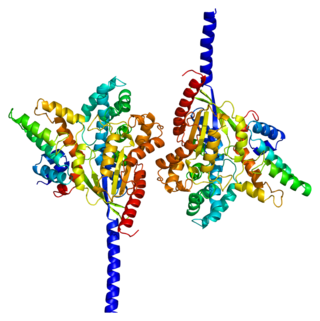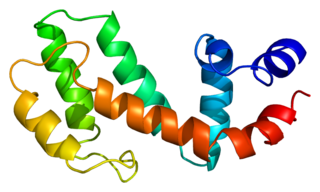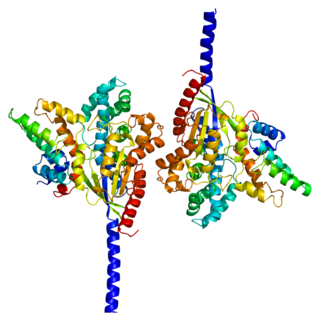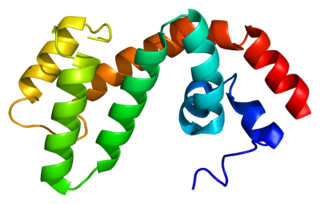Regulator of G-protein signaling 14 (RGS14) is a protein that in humans is encoded by the RGS14 gene. [5]
Regulator of G-protein signaling 14 (RGS14) is a protein that in humans is encoded by the RGS14 gene. [5]
RGS14 is a member of the regulator of G protein signalling family. This protein contains one RGS domain, two Raf-like Ras-binding domains (RBDs), and one GoLoco motif. The protein attenuates the signaling activity of G-proteins by binding, through its GoLoco domain, to specific types of activated, GTP-bound G alpha subunits. Acting as a GTPase activating protein (GAP), the protein increases the rate of conversion of the GTP to GDP. This hydrolysis allows the G alpha subunits to bind G beta/gamma subunit heterodimers, forming inactive G-protein heterotrimers, thereby terminating the signal. Alternate transcriptional splice variants of this gene have been observed but have not been thoroughly characterized. [5]
Increasing the expression of the RGS14 protein in the V2 secondary visual cortex of mice promotes the conversion of short-term to long-term object-recognition memory. [6] Conversely RGS14 is enriched in CA2 pyramidal neurons and suppresses synaptic plasticity of these synapses and hippocampal-based learning and memory. [7]
RGS14 has been shown to interact with:

Regulator of G protein signaling 4 also known as RGP4 is a protein that in humans is encoded by the RGS4 gene. RGP4 regulates G protein signaling.

Regulator of G-protein signaling 2 is a protein that in humans is encoded by the RGS2 gene. It is part of a larger family of RGS proteins that control signalling through G-protein coupled receptors (GPCR).

Guanine nucleotide-binding protein G(i), alpha-1 subunit is a protein that in humans is encoded by the GNAI1 gene.

Regulators of G protein signaling (RGS) are protein structural domains or the proteins that contain these domains, that function to activate the GTPase activity of heterotrimeric G-protein α-subunits.

Guanine nucleotide-binding protein G(o) subunit alpha is a protein that in humans is encoded by the GNAO1 gene.

Guanine nucleotide-binding protein G(z) subunit alpha is a protein that in humans is encoded by the GNAZ gene.

Regulator of G-protein signaling 16 is a protein that in humans is encoded by the RGS16 gene.

Regulator of G-protein signaling 19 is a protein that in humans is encoded by the RGS19 gene.

Guanine nucleotide-binding protein subunit beta-5 is a protein that in humans is encoded by the GNB5 gene. Alternatively spliced transcript variants encoding different isoforms exist.

Guanine nucleotide-binding protein G(t) subunit alpha-1 is a protein that in humans is encoded by the GNAT1 gene.

Regulator of G-protein signaling 20 is a protein that in humans is encoded by the RGS20 gene.

Regulator of G-protein signaling 12 is a protein that in humans is encoded by the RGS12 gene.

Regulator of G-protein signaling 18 is a protein that in humans is encoded by the RGS18 gene.

Regulator of G-protein signalling 9, also known as RGS9, is a human gene, which codes for a protein involved in regulation of signal transduction inside cells. Members of the RGS family, such as RGS9, are signaling proteins that suppress the activity of G proteins by promoting their deactivation.[supplied by OMIM]

Regulator of G-protein signaling 6 is a protein that in humans is encoded by the RGS6 gene.

Guanine nucleotide-binding protein G(k) subunit alpha is a protein that in humans is encoded by the GNAI3 gene.

Guanine nucleotide-binding protein subunit alpha-12 is a protein that in humans is encoded by the GNA12 gene.

Regulator of G-protein signaling 17 is a protein that in humans is encoded by the RGS17 gene.

Regulator of G-protein signaling 11 is a protein that in humans is encoded by the RGS11 gene.

GoLoco motif is a protein structural motif. In heterotrimeric G-protein signalling, cell surface receptors (GPCRs) are coupled to membrane-associated heterotrimers comprising a GTP-hydrolyzing subunit G-alpha and a G-beta/G-gamma dimer. The inactive form contains the alpha subunit bound to GDP and complexes with the beta and gamma subunit. When the ligand is associated to the receptor, GDP is displaced from G-alpha and GTP is bound. The GTP/G-alpha complex dissociates from the trimer and associates to an effector until the intrinsic GTPase activity of G-alpha returns the protein to GDP bound form. Reassociation of GDP-bound G-alpha with G-beta/G-gamma dimer terminates the signal. Several mechanisms regulate the signal output at different stage of the G-protein cascade. Two classes of intracellular proteins act as inhibitors of G protein activation: GTPase activating proteins (GAPs), which enhance GTP hydrolysis, and guanine dissociation inhibitors (GDIs), which inhibit GDP dissociation. The GoLoco or G-protein regulatory (GPR) motif found in various G-protein regulators. acts as a GDI on G-alpha(i).